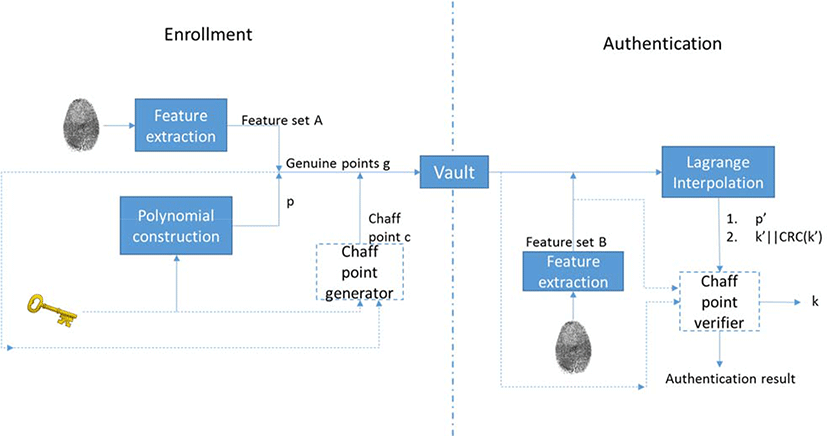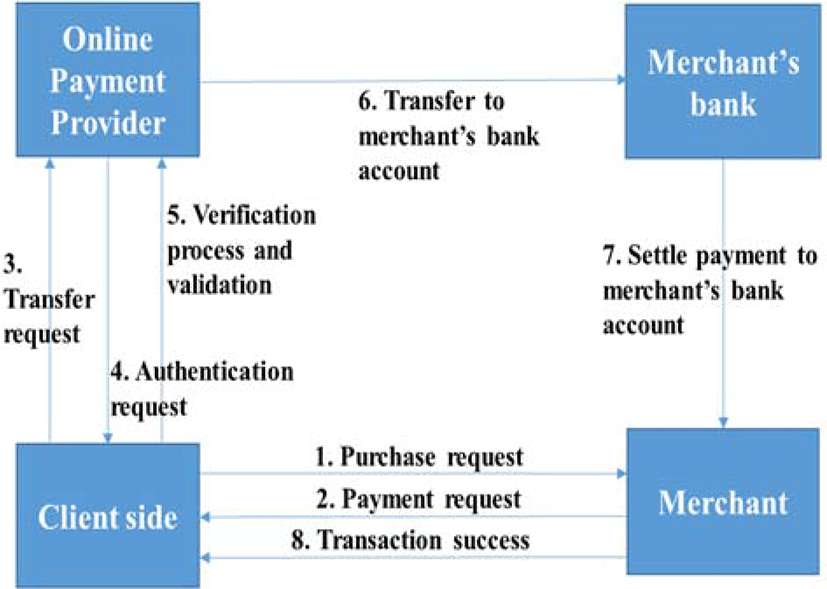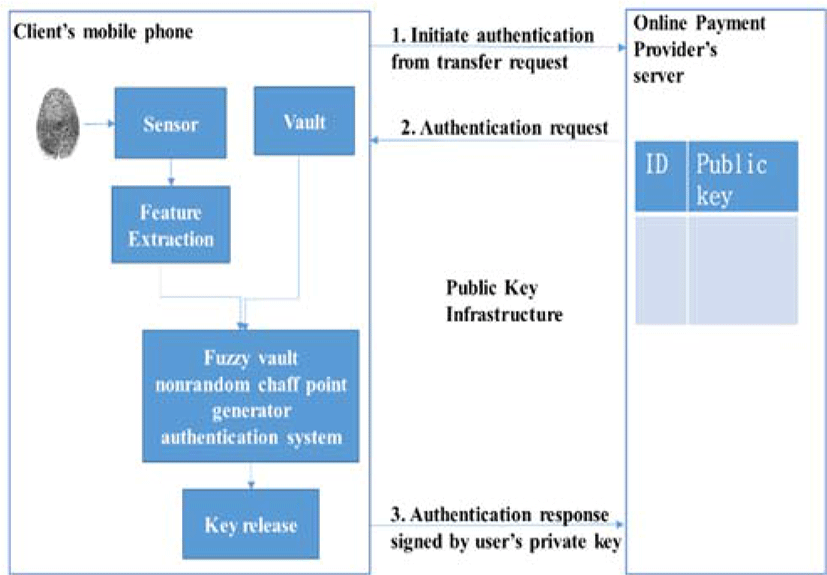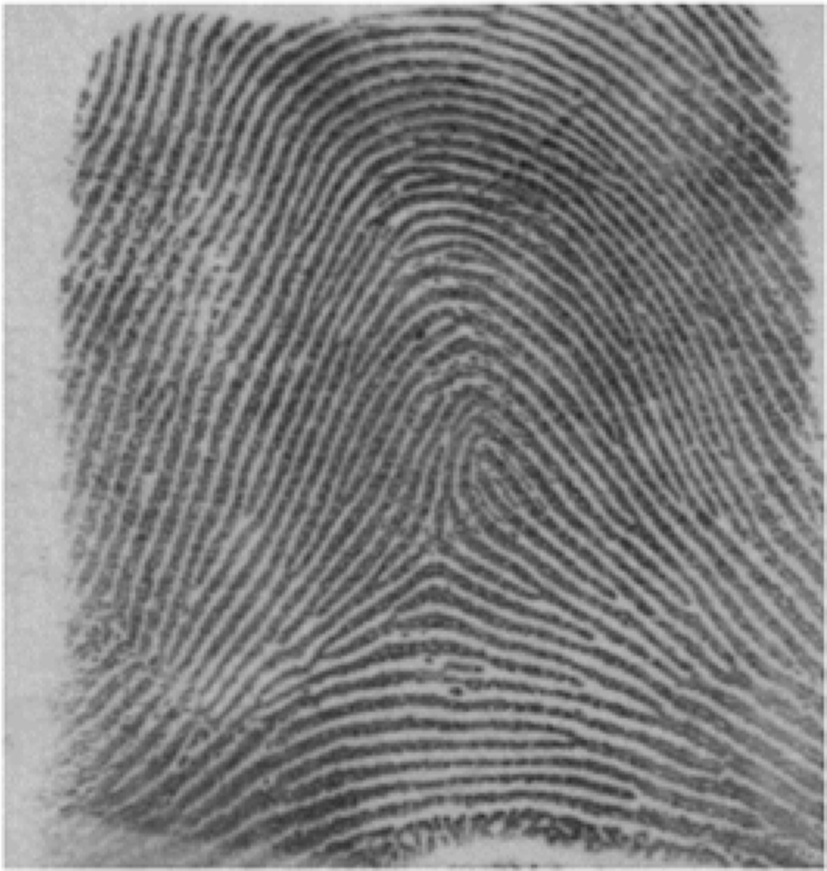I. INTRODUCTION
Authentication process is one of the security concerns in mobile payment account-based scenarios. Nowadays, biometric authentication is becoming a popular technique for authentication in mobile phones because of its simplicity and ease of execution [1]. Moreover, sensor improvements in mobile phones make it possible to easily collect biometric data, e.g. fingerprint scanners have already been embedded in mobile phones. Biometric authentication has more advantages over other forms of authentication. One of the advantages is that a unique identity is used which is hard to imitate.
The main concern of biometric authentication system is to secure the biometric templates of the user. Because the biometric features are immutable and limited, a compromise of biometric templates causes permanent loss of a subject’s biometrics [2]. As a consequence, a robust security scheme is needed to protect the biometric templates. There are several methods for securing biometric templates [2,3], one of them is biometric cryptosystems (BCs). BCs require a storage of biometric information to retrieve or generate cryptographic keys, referred as helper data. These helper data are stored as an encrypted form and do not reveal significant information about the biometric templates and the cryptographic keys. BCs are more practical than other methods because most of the mobile payment systems use a cryptographic key for securing mobile payment transaction over open networks [4-7].
In this paper, a method to enhance biometric authentication security in account-based mobile payment systems over open networks using biometric cryptosystems based on fuzzy vault non-random chaff point generator is introduced. One of the important steps in fuzzy vault non-random chaff point generator is feature extraction. This paper evaluates some feature extraction methods to enhance the accuracy of the system. In Section 2, recent developments of fuzzy vault method are reviewed. In Section 3, fingerprint feature extraction as a preprocessing step in fuzzy vault is explained. The proposed method is explained in Section 4. Section 5 shows the experiment and result. Section 6 contains discussion, while future works and the conclusion are presented in Section 7.
II. LITERATURE REVIEW
Fuzzy vault is one of the biometric cryptosystems based on key binding schemes that were introduced by Juels and Sudan in 2002 [8]. Since then, various developments of fuzzy vault have been proposed. The original scheme uses the Reed-Solomon code for error-correcting code that can handle noisy data and is designed for an unordered set of data. In recent years, the implementation of Cyclic Redundancy Check code (CRC) and Lagrange interpolation are introduced to replace Reed-Solomon code. However, the CRC-based fuzzy vault scheme still needs some improvements. Recent research on CRC-based fuzzy vault methods focus on preventing attacks such as brute force attack, statistical analysis attack, collusion attack, and blend substitution attack [9].
Benhammadi et al. [10] proposed a new method using password hardened fuzzy vault based on an improvement of fingerprint feature representation. Khalil-Hani et al. [11] changes the whole scheme by considering non-random chaff point generator which is computationally fast. These two methods only prevent statistical analysis attack. Nguyen et al. [12] proposed a new fuzzy vault method using ridge features. This method resists against advanced brute force attack. Dang et al. [13] proposed a cancellable fuzzy vault. The proposed method performs a periodic transformation on the biometric template. This method is robust against brute force attack. However, this method is possible to be cracked by statistical analysis attack.
Another scheme was proposed by M.T. Nguyen et al. [14] in early 2016. This method focuses on preventing the aforementioned attacks, especially blend substitution attack. This scheme introduces a modified chaff point generator and verifier. This non-random chaff point generator and verifier substitute CRC algorithm for error correcting check. The schematic of this method can be seen in Figure 1. Continuous hashing and linear projection are used to generate chaff from cryptographic key and biometric template in enrollment phase. As a consequence, the same chaff point will be regenerated as a verifier in the authentication phase. In this scheme, chaff point is not a random point but a point that is treated as the signature for the combination of biometric template and cryptographic key. If there are any modifications in the vault, then this system can detect the modification and the authentication will fail.
III. FINGERPRINT FEATURE EXTRACTION
In this section, a brief introduction to fingerprint feature extraction is explained. Minutiae extraction is one of the feature extraction methods for fingerprint. Minutiae extraction is widely used and is also one of the old methods in feature extraction field. In fuzzy vault, feature extraction is a preprocessing step for getting genuine points from the biometric sample. The input for this step is a biometric image from the sensor, and the output is a set of genuine points as the unique identity of the biometric sample. To get a high performance of the fuzzy vault system, we have to select an accurate feature extraction method. Accurate feature extraction will help in decreasing False Acceptance Rate (FAR) and False Rejection Rate (FRR). An accurate extraction method must have the capability of extracting salient features from fingerprints in a robust way. The False Negative (FN) rate and False Positive (FP) rate of the extracted genuine points should be minimized.
There are many minutiae extraction methods that have been introduced by researchers to obtain a high performance fingerprint feature extraction [15]. Distortion is a major concern in developing feature extraction methods. Distortion in fingerprints comes from variations in skin and impression condition when the user inserts their fingerprint from the sensor.
Minutiae extraction can be done in binarized fingerprint image or gray scale fingerprint image. Binarized fingerprint image can be divided into two types, unthinned binarized images and thinned binarized images. One of the example methods that uses unthinned binarized images is ridge flow and local pixel analysis. In [16] a method based on ridge flow was used. This proposed method scans the binary images of a fingerprint, identifying localized pixel patterns that indicate the ending or splitting of a ridge. For example, a pattern may represent the end of a black ridge protruding into the pattern. Another example method that uses thinned binarized images is based on Crossing Number. In [17], Wu Zhili uses a modified crossing number method to extract minutiae points from fingerprint.
In Section 5, several minutiae extraction methods are evaluated. The purpose of the section is to select an accurate and suitable minutiae extraction method for the fuzzy vault system.
IV. PROPOSED METHOD
In this section, we propose a method to enhance the security in mobile payment authentication systems with account-based remote payment scenario. The interactions among concerned parties in an account-based remote payment scenario are illustrated in Figure 1. There are four components included in this scenario: the client, the merchant, the merchant’s bank, and the Online Payment Provider. Communications among these concerned parties are done in a secure protocol.
First, the user registers their account to the Online Payment Provider together with their fingerprint information through the sensor. In this phase, the online payment provider will configure the client phone to generate private and public keys for the next communication. Authentication is done if the client makes a transfer request from their mobile phone. The authentication process between the client side and the server side of the online payment provider can be seen in Figure 2. Matching is done in the client side using fuzzy vault non-random chaff point generator scheme. Vault points as helper data are stored in the mobile phone’s local data. These vault points come from a non-random chaff point generator and polynomial reconstruction of the biometric template and the cryptographic key.
Public key infrastructure is involved in the authentication process between the Online Payment Provider’s server and the client’s mobile phone. The client’s private key is used for signing an authentication response. Then the server validates the authentication response using the client’s public key on the database. After that, the server checks the client account’s balance. If there are sufficient funds, then the Online Payment Provider initiates a money transfer to the merchant’s bank. Then the merchant gives a notification to the client that the transaction has been approved.
The overall process in mobile payment authentication system based on the fuzzy vault non-random chaff point generator is described in the explanation below.
In enrollment phase, the user makes an account in Online Payment Provider including their unique ID. A random pair of public key and private key is generated in the user’s mobile phone. Then the user’s mobile phone requests the certificate to Certificate Authority (CA). If the registration data of the user are valid, the Online Payment Provider (OPP) will enroll the user ID together with his corresponding public key to OPP’s server database. After that, the user inserts his fingerprint template. This fingerprint template will become an input for the feature extraction module. Feature points are extracted from the fingerprint template in the feature extraction module using the minutiae extraction method. Genuine points are constructed by polynomial construction using the registered private key and feature points as inputs. Chaff points are generated using Chaff Points Generator in [14]. Genuine points and chaff points are combined together and become vault points. These vaults points are stored in the user’s mobile phone, for future usage in authentication phase.
In the authentication phase, if a user sends a transfer request to OPP, an authentication request and challenge message are sent back by OPP to the user’s mobile phone. The system then requests the user to insert his fingerprint. This fingerprint image that is captured by the mobile phone’s sensor is inserted to the feature extraction module. Once again, feature points are obtained from the biometric sample. A candidate genuine set is selected by selecting vault points based on the feature points. Using Lagrange interpolation, the polynomial equation is reconstructed and private key is generated. After the private key is acquired, the system executes Chaff Point Verifier in [14] and the authentication result and private key are issued. This private key is used to sign the challenge message request from the OPP, and the OPP will verify the identity of the user in the OPP server.
Performance of biometric authentication is considered in terms of FRR, FAR and Equal Error Rate (EER) [18], [19]. These metrics are used to measure the performance of fuzzy vault non-random chaff point generator which is implemented in mobile payment system. To reduce FAR and increase FRR, choosing an optimal value of variables in fuzzy vault system is an important task.
V. EXPERIMENT AND RESULT
The proposed method is still in a work in progress, therefore not all of the modules in the scheme have been implemented. In this section, feature extraction for fuzzy vault system on mobile payment authentication is selected and implemented.
The input data that is used for testing the system is fingerprint NIST Special Database 04 (SD04). The original SD04 data is an ANSI/NIST format (AN2) file. This database contains 8-bit grayscale images of randomly selected fingerprints. This file contains 4000 (2000 pairs) fingerprints stored in PNG (image) files format and TXT (data) files with information extracted from the AN2 file. Each print is 512 × 512 pixels with 32 rows of white space at the bottom of the print. The fingerprints are classified into one of five categories (L = left loop, W = whirl, R = right loop, T = tented arch, and A = arch). For this implementation, the database from figs_0 is used. The record file holds the image for the subject and some information pertaining to the image in text file. The field that has the CLASS and HISTORY values e.g., “CLASS:R, History: f0023_04.pct R a2804.pct” is extracted and put onto the text file together with the Gender value.
The feature extraction method is implemented in Xamarin IDE that is already embedded in Microsoft Visual Studio 2015. Xamarin is an IDE for mobile application development that uses C# and can be used for code compiling across all mobile development platforms such as iOS, Windows Mobile and Android.
In this section, a comparison between two minutiae feature extractions is shown in Table 1 and performance is evaluated. The first algorithm is SourceAFIS SDK [20] for feature extraction based on ridge flow and local pixel analysis [16]. The second algorithm [21] is based on modified Crossing Number [17].
| Input Image | Output [20] | Output [21] |
|---|---|---|
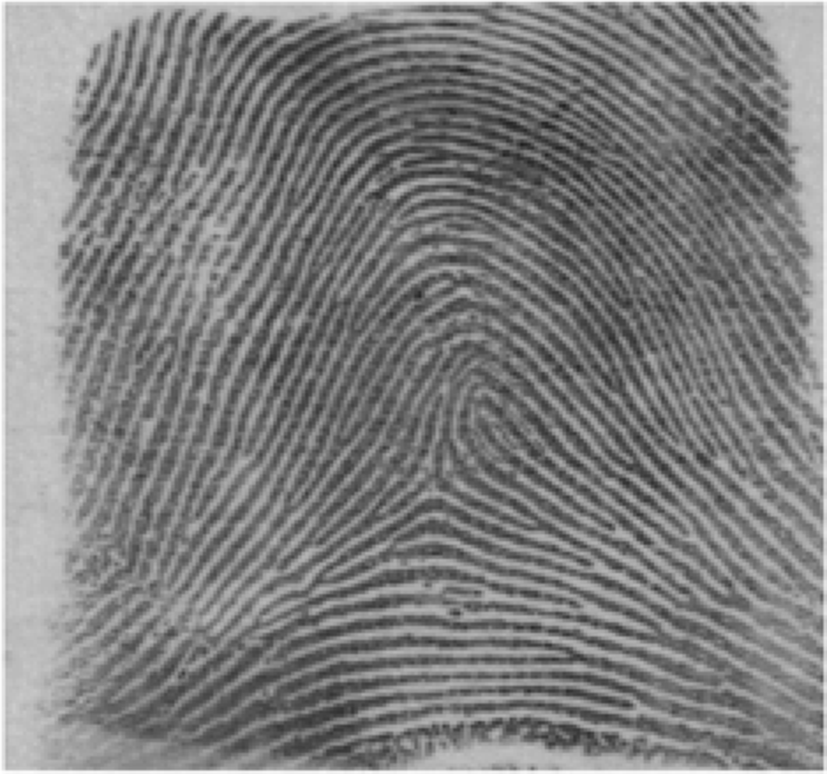
|
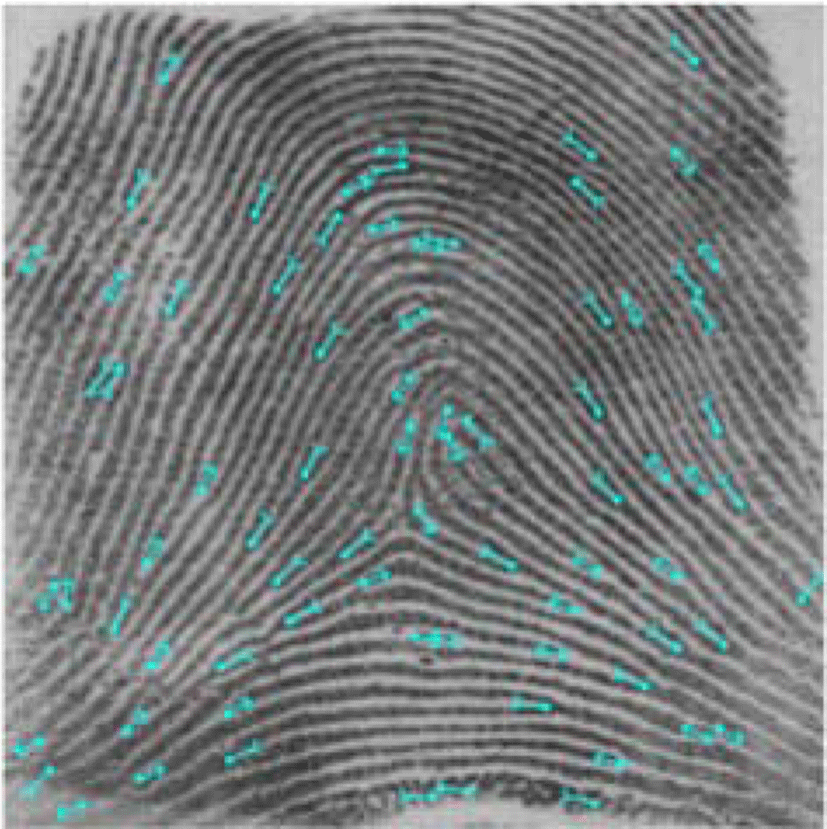
|
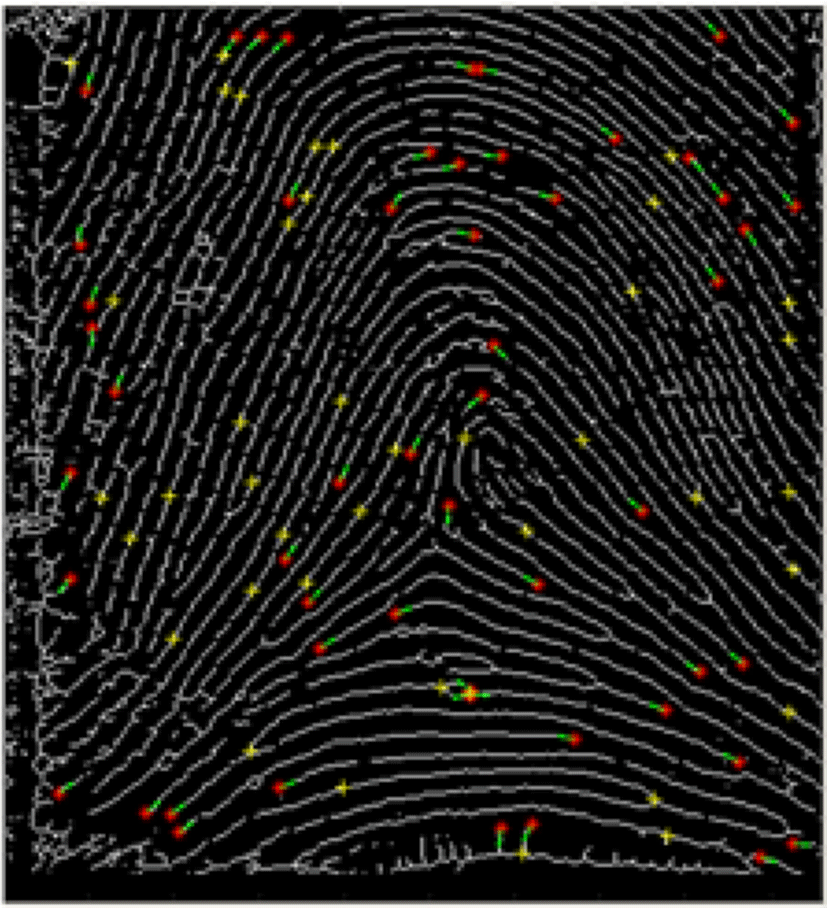
|
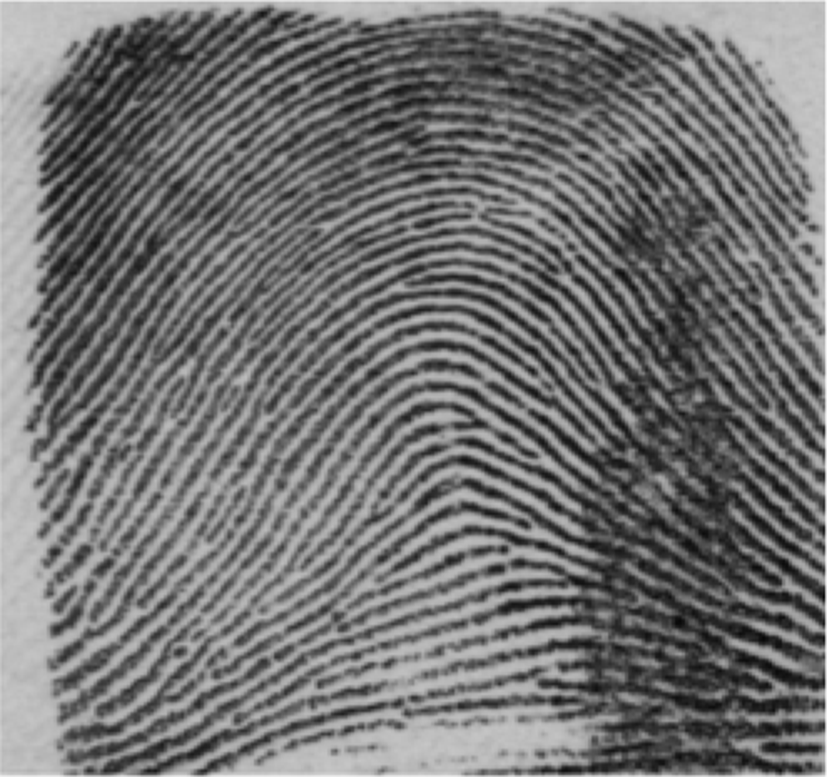
|
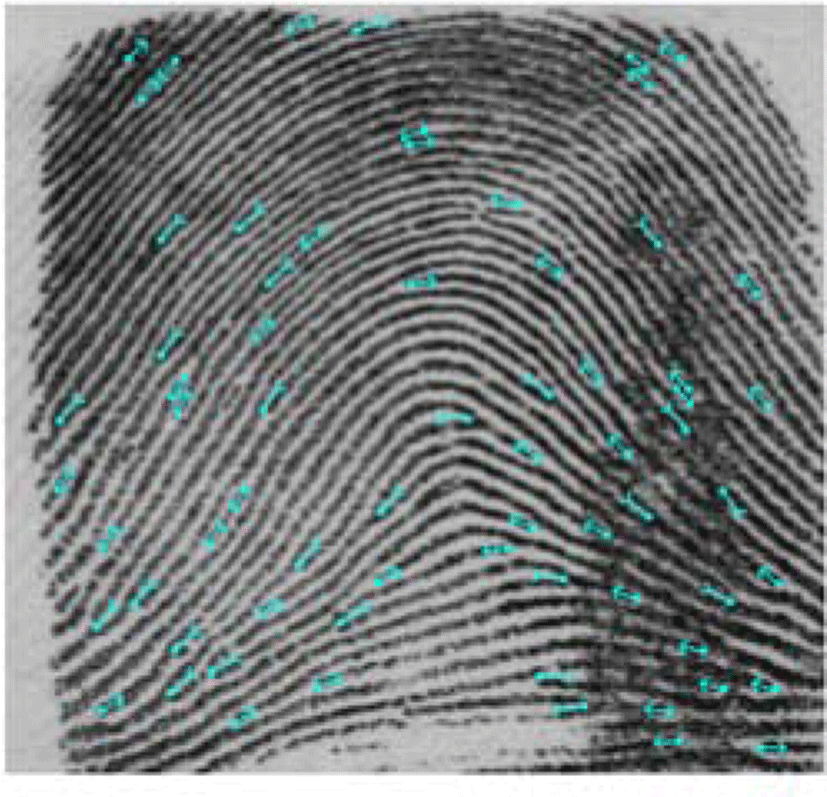
|
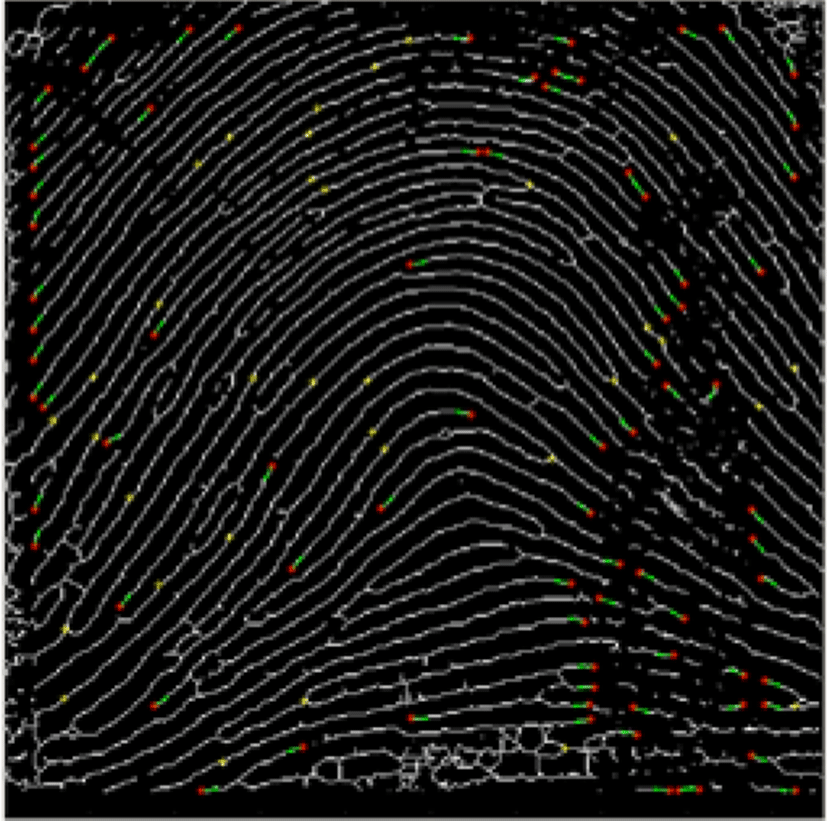
|
VI. DISCUSSION
Securing biometric templates is a major concern in biometric authentication. If the matching process only uses the biometric template itself, then it is better to store the biometric data in the server side since attacking the server is more difficult than attacking the client (i.e. mobile phone). However, there are some disadvantages if the biometric templates are stored in the server side. First, if an attack occurs, then the possibility of data loss is high. Second, there is no privacy for client’s biometric data in the server side. To protect the client’s privacy, it is more convenient to store the biometric data in the client’s mobile phone. To prevent data leakage, the biometric templates must be stored in a secure manner. Biometric cryptosystems are a suitable solution to secure biometric templates for authentication method in the client side.
To enhance the performance of the fuzzy vault system, we must consider every step, including the feature extraction step. The feature extraction step produces genuine points from fingerprint as an input for fuzzy vault system. These genuine points are used in the enrollment and authentication phases in the mobile payment system. Accurate genuine points are an important parameter to enhance the accurate performance of the system. Considering the best feature extraction algorithm for the system is a must, especially given distortion in the input image while the enrollement process is performed. We have to select an algorithm that can handle distortion regions in the input images. A distortion region can be a low quality region, border area, or high curve region. In such a distortion region, the possibility of false minutiae as genuine points is high.
Based on the comparison result in section 5, the algorithm in [20] can handle the distortion region to reduce false minutiae detection, in contrast with the algorithm in [21]. Table 1 shows many false minutiae in border region are detected by the algorithm in [21].
VII. CONCLUSION AND FUTURE WORK
In this paper, a method is proposed to enhance the authentication security in account-based mobile payment systems while the matching process is done on the client side. Communication between the client and the Online Provider Payment’s server is done using public key infrastructure. The proposed method uses fuzzy vault BCs key binding technique based on non-random chaff point generator in [14]. This method resolves the previous attacks reported in [9]. A fingerprint feature extraction method is evaluated as an important step in the fuzzy vault system to enhance the accuracy of the system.
For future work, we will implement the proposed method as a mobile application. To achieve a high performance of the proposed method, optimal values of other variables in fuzzy vault non-random chaff point generator should be considered.
